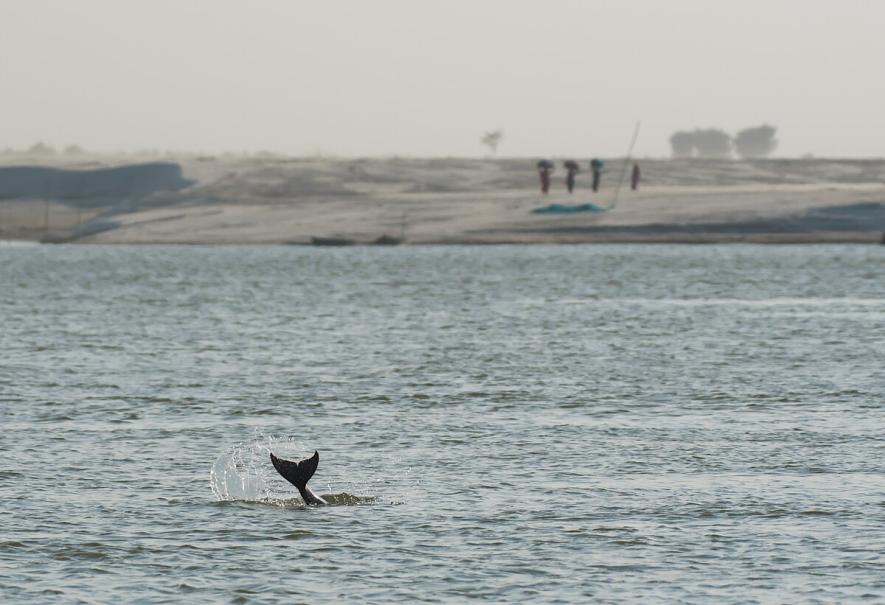Bihar: Rampant Illegal Sand Mining Threatens Gangetic River Dolphins in Ganga, Tributaries

Gangetic dolphin. (Image credit: Wikimedia Commons/Mrinal Kaushik)
Patna: As illegal sand mining by powerful sand mafia continues in Ganga and its tributaries in Bihar on a large scale, contrary to the claim of governments, it is adversely affecting Gangetic the river
dolphins’ food and natural habitat. Even during ongoing monsoon, when sand mining has been banned on paper officially in compliance with the order of the National Green Tribunal, rampant illegal sand mining is going posing a danger to Gangetic dolphins in Ganga, and its tributaries Gandak, Ghaghra, Mahananda, Parman and Kosi.
Experts say though government agencies have been working for conservation of this national aquatic animal (dolphin), illegal sand mining should be stopped for their survival of them. Large-scale illegal sand mining is damaging river beds and its ecology. It is also changing the morphology and natural flow of rivers, as huge volumes of sand is being extracted through machines.
The damage to river biodiversity is badly affecting the habitat and staple food (fish, mainly small fish) of Gangetic dolphins (platanista gangetica). Extract sand from river beds is also posing a serious threat to dolphins because they spent most of their time under water and come out for few seconds to breathe. Mechanised digging of river bed in Sone, Ganga and tributaries have created ditches and big pit, bad for rive health, add experts.
Taking note of this, the state government has initiated several measures, including crackdown on the powerful sand mafia but has failed to stop it. It has now chalked out an action plan against the sand mafia. The Bihar Police ‘s Economic Offences Unit (EOU) has prepared a list of 55 sand mafia who are accused of involvement in illegal sand mining in 13 districts -- Patna, Bhojpur, Gaya, Saran, Bhagalpur, Rohtas, Aurangabad, Arwal, Jehanabad, Banka, Nawada.
Meanwhile, a latest study has found the presence of Gangetic dolphins in Ganga tributaries, which is good news amid the
dwindling numbers of this species in Ganga. The Wildlife Institute of India reportedly revealed that there were 4,000 dolphins in Ganga and its tributaries.
However, the fisher community, allegedly being blamed for occasional killing of dolphins, said they were being wrongly accused and claimed that it was the illegal sand mafia operating in violation of the Wildlife Protection Act 1972 and other forest Acts, NGT’s regulations and Bihar Pollution Control Board’s guidelines that was to blame.
“Our livelihood is affected by illegal sand mining because it badly hits river fish. We are poor and falsely targeted for disturbing dolphins in rivers, but the sand mafia are powerful and continue to operate in lucrative illegal sand mining, which is posing the real danger to dolphins”, Anil Shahni, a fisherman near Digha ghat in Patna, said.
Gangetic river dolphins expert R K Sinha also expressed serious concern over survival of Gangetic river dolphins in the coming years if illegal sand mining continues. "Illegal sand mining is not only a threat but a real danger to the endangered Gangetic river dolphins because it has been disturbing their habitat, ending their staple food -fish - and destroying river ecology,” Sinha told NewsClick.
Sinha, who was behind India’s Conservation Action Plan for the Gangetic dolphin 2010-20, said dolphins usually search for its food – fish -- on riverbeds, but illegal sand mining is causing a decline in the numbers of fish in rivers. What dolphins will eat to survive?
Sinha, also known as the 'Dolphin Man', said that the presence of dolphins’ was a sign of a healthy river ecosystem.
“Dolphins prefer water that is at least 5-8-feet deep. They are usually found in turbulent waters, where there are enough fish for them to feed on”, he added.
Gangetic dolphins live in a zone where there is little or no current, which helps them save energy. If they sense danger, they can dive into deep waters. They swim from the no-current zone to the edges to hunt for fish and return, he said.
According to a recent report by Nichiket Kelkar and Tarun Nair, associated with the Wildlife Conservation Trust, sand mining threatens the survival and persistence of endangered riverine species like the gharial crocodile, freshwater turtles, otters, river dolphins, and water birds, as it destroys their nesting and breeding habitats.
Gopal Sharma, a senior scientist at the Zoological Survey of India, said, ”More than any other activities, illegal sand mining is increasing the danger for Gangetic dolphins. The state government should focus on checking illegal sand mining”.
Vikramshila Gangetic Dolphin Sanctuary in Bhagalpur district is India's only such sanctuary, spread over 50 km along the Ganges. In 2019, a team of researchers, on behalf of the government of Bihar, for the first time conducted a survey to assess the status of the dolphins in five rivers -- Parman, Bakra, Kankai, Mechi and Mahananda.
According to the survey, a total of 245 km was covered during the survey of the five rivers, in which dolphins were observed and documented in the Mahananda river only. The other rivers were too shallow. Parman was the only river where local people said that the dolphins could still be seen then.
“This dolphin species is very unique and is unlike any other dolphin species that exists today, because it is functionally blind. As the Himalayan rivers in the Ganga-Brahmaputra basin carry loads of sediment and are very murky, the river dolphin has lost its eyes naturally in the course of evolution. It navigates and searches for prey using echolocation by emitting ultrasonic click-sounds. This rare and fascinating animal is today highly threatened by multiple factors, of which the availability of
water is a primary threat”, the report said.
Sinha said that Gangetic dolphins' habitat also faces serious threats from climate change. He pointed out that increasing pollution due to large-scale discharge of industrial and municipal waste, siltation, and mechanised boats were the biggest threat to these freshwater dolphins.
The Gangetic river dolphin also frequently fall prey to poachers.
Their carcasses are found regularly on river banks.
Gangetic river dolphins fall under Schedule I of the Indian Wildlife (Protection) Act, and have been declared an endangered species by the International Union for Conservation of Nature (IUCN).
The Gangetic river dolphin is one of the four freshwater dolphin species in the world. The other three are found in the Yangtze river, China, the Indus river in Pakistan and the Amazon river in South America.
The Gangetic river species – found in India, Bangladesh and Nepal – is blind and finds its way and prey in the river waters through echoes.
The writer is a freelance journalist based in Patna.
Get the latest reports & analysis with people's perspective on Protests, movements & deep analytical videos, discussions of the current affairs in your Telegram app. Subscribe to NewsClick's Telegram channel & get Real-Time updates on stories, as they get published on our website.























